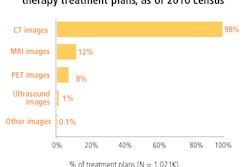The New York Times this week once again took aim at radiation oncology. In a December 28 article, investigative reporter Walt Bogdanich detailed a series of treatment errors that occurred when linear accelerators were outfitted with cone attachments to enable them to perform stereotactic radiosurgery.
The article is part of a continuing series by Bogdanich on deadly and debilitating mistakes being made while delivering radiation therapy, as well as gaps in oversight by federal regulatory agencies and the fragmented reporting structure of adverse events in the U.S. that often fails to identify problems.
The current story describes how radiation oncology facilities are using linear accelerators retrofitted with cone attachments to be used with stereotactic radiosurgery (SRS) systems. The retrofits can enable cancer treatment centers to offer the procedure without purchasing an expensive dedicated system such as Gamma Knife (Elekta, Stockholm).
But retrofitted linacs have been responsible for several cases in which fatal or seriously debilitating levels of radiation have been delivered to patients without clinical staff being alerted to a problem, according to the article.
Bogdanich reports on the fate of a woman who underwent stereotactic radiosurgery at Evanston Hospital in Evanston, IL, for trigeminal neuralgia, a facial pain emanating from the trigeminal nerve at the base of the brain. A linear accelerator that was retrofitted by Varian Medical Systems of Palo Alto, CA, to perform SRS was used.
The system allowed radiation to spill outside a heavy metal cone attachment that was supposed to channel the high-intensity radiation beam to a precise location in the brain, according to the story. The unit lacked some safety features, including those that might have prevented radiation from leaking outside the cone, Bogdanich wrote.
The NY Times article stated that this radiation delivery mistake occurred with two other patients having the same procedure before it was identified. William David Bloomer, MD, chairman of radiation medicine at Evanston Hospital, said that the errors occurred even though the manufacturer's instructions had been followed.
The adverse incidents were reported immediately, and the three patients were notified. One of the patients is severely debilitated as a result of the radiation overdose, nearly comatose and living in a nursing home at the age of 50.
In the past five years, stereotactic radiosurgery systems made by Varian and BrainLab of Feldkirchen, Germany, have been involved in "scores of errors and overdoses," according to Bogdanich. The NY Times attributed these adverse incidents to operator error and also to vital electronic components not communicating with each other properly.
"The accidents highlight shortcomings in the regulation of medical radiation," Bogdanich wrote. "Despite their complexity, the multipurpose devices are less regulated than their more simply designed competitor, the Gamma Knife, a device engineered specifically for stereotactic radiosurgery."
He pointed out that linear accelerators are regulated by the U.S. Food and Drug Administration (FDA), while products using a radioactive isotope, such as Gamma Knife, are regulated by the Nuclear Regulatory Commission (NRC).
The retrofitted linear accelerators were approved by the FDA with little review on the grounds that they were mere extensions of existing technology, according to the article.
It is impossible to know how many adverse incidents are occurring with linear accelerators retrofitted for use as SRS systems. Nor is there a database to report any error involving a linear accelerator, the article pointed out.
By Cynthia E. Keen
AuntMinnie.com staff writer
December 30, 2010
Related Reading
Patient safety symposium draws crowds at AAPM, July 22, 2010
FDA schedules meeting on RT error reduction, May 10, 2010
Societies to host meeting on radiation safety, April 16, 2010
Second NY Times article highlights radiation therapy errors, January 29, 2010
NY Times article details radiation therapy errors, January 26, 2010
Copyright © 2010 AuntMinnie.com



















